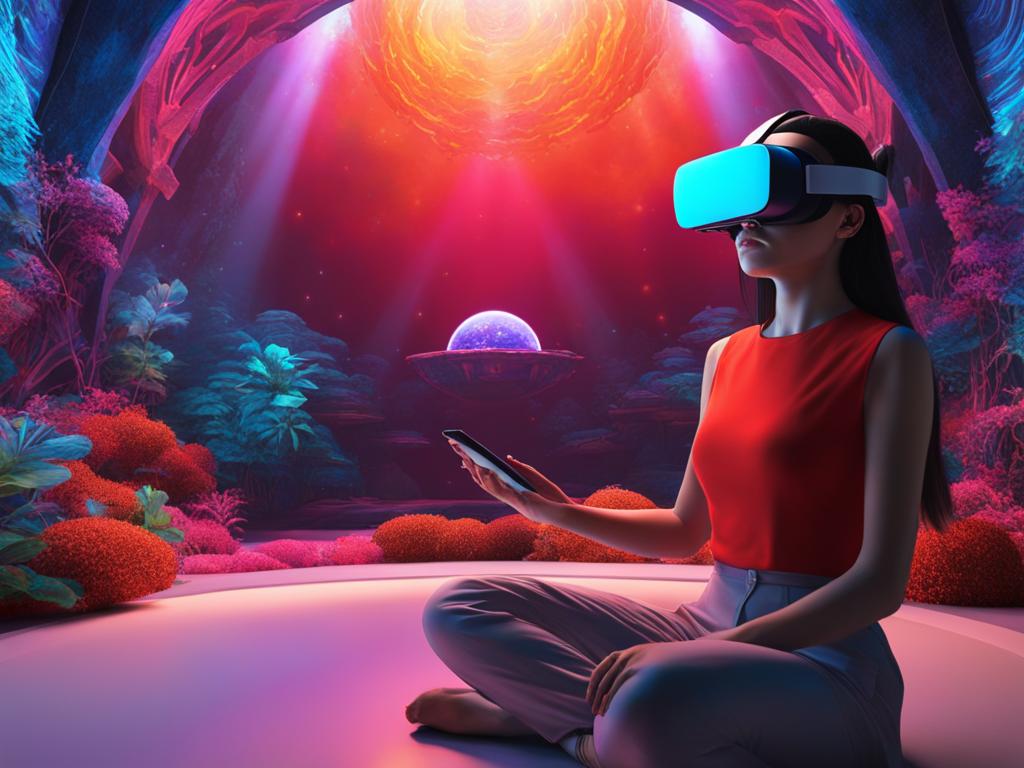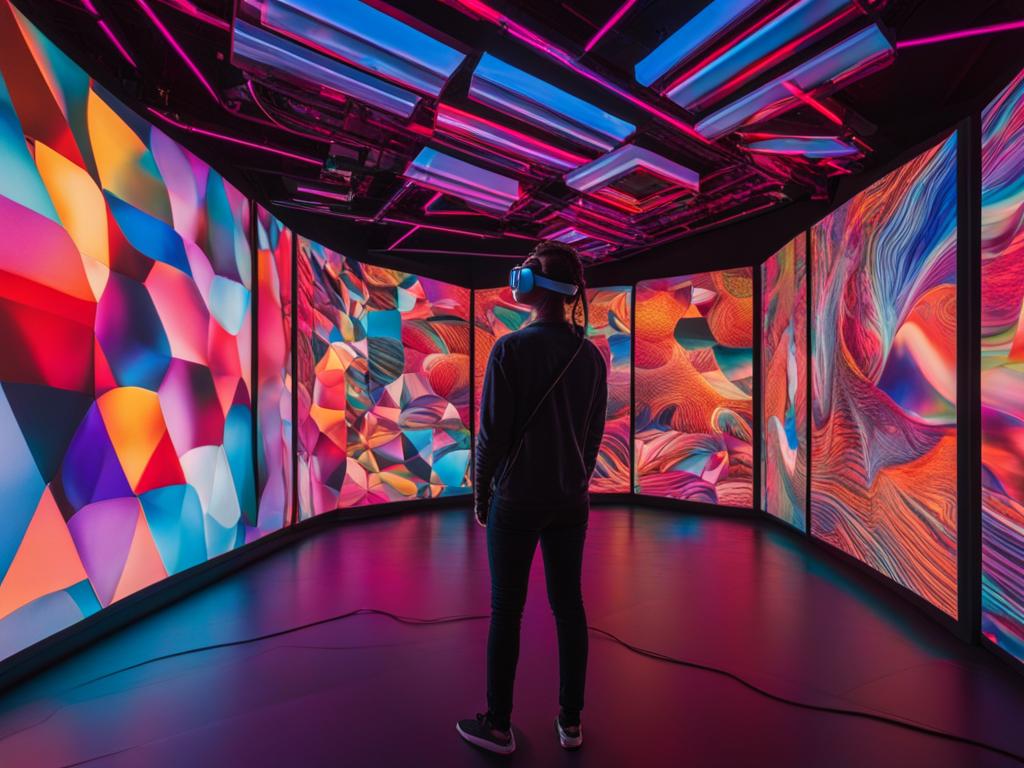Gone are the days when art was confined to museums and galleries. Welcome to a world where art transcends boundaries, where viewers are no longer passive observers but active participants in a three-dimensional virtual environment. This is the world of virtual reality art, where technology and creativity meld to create immersive art experiences like no other.
Whether it’s VR art exhibitions, augmented reality art, interactive digital art, virtual reality installations, digital art galleries, or VR art platforms, virtual reality art has transformed the art world. With virtual reality sculpture and painting, artists can create worlds beyond imagination. This medium not only challenges conventional notions of art forms but expands the possibilities of creative expression as we know it.
In this article, we will explore the evolution of virtual reality art, the techniques used in creating it, and its impact on the art world. We will take a closer look at the immersive experiences, virtual reality art galleries, exhibitions, and platforms. We will dive deep into augmented reality and interactive digital art and explore their unique role in creating immersive environments. To summarize, in this upcoming article, we will take a deep dive into the wonders of virtual reality art and let our minds run wild.

The Evolution of Virtual Reality Art
Virtual reality art has come a long way since its inception. In the early 1990s, it was primarily used as a tool for creating 3D models and animations, but it wasn’t until the mid-2000s that artists began to use virtual reality technology as an artistic medium. Since then, virtual reality art has evolved significantly, and its influence can be seen across the fields of art and technology.
One significant milestone in the evolution of virtual reality art was the advent of the Oculus Rift headset in 2012. This major breakthrough in virtual reality technology made it possible for artists to create fully immersive virtual environments that could be experienced by viewers in a lifelike setting. The sense of presence created by the Oculus Rift marked a turning point in the evolution of virtual reality art.
| Decade | Major Technological Milestones |
|---|---|
| 1950s | The first interactive computer graphics program developed |
| 1990s | The first virtual reality headsets invented |
| 2000s | Artists begin to experiment with virtual reality technology as a medium |
| 2010s | The advent of the Oculus Rift and other major advancements in virtual reality technology |
As virtual reality art continues to progress, we can expect to see even more advanced techniques and technologies being used in its creation. From 3D modeling and animation to interactive installations and haptic feedback, the possibilities are endless.
With the evolution of virtual reality art, we have seen a shift in the way that art is created and consumed. Where once art was limited by physical space and materials, virtual reality art allows artists to create and showcase their work in entirely new ways. As this unique art form continues to evolve, it will be exciting to see where it will take us next.
Techniques in Virtual Reality Art
Virtual reality art creation involves the use of unique techniques that are distinct from traditional art forms. The most common technique used in virtual reality art is 3D modeling, which enables the creation of virtual objects and environments that can be explored in great detail. This technique involves the use of complex software tools to create intricate 3D models and textures that can be experienced in three dimensions through a VR headset.
Another technique used in virtual reality art is animation, which involves the creation of lifelike movements for virtual objects. This technique is critical in creating immersive environments that capture the viewer’s attention and create emotional experiences. The use of interactive elements such as buttons, triggers, and movements is also common in virtual reality art, enhancing the viewer’s interaction with the artwork.
Virtual reality art installations are also characterized by their incorporation of sound, haptic feedback, and other sensory inputs. The use of sound effects, voiceovers, and background music can elevate the viewer’s experience, adding depth and emotional resonance to the artwork. Haptic feedback, which involves the use of touch-based feedback systems, helps to create a sense of presence and immersion, enhancing the viewer’s connection with the virtual world.
The techniques used in virtual reality art enable the creation of immersive environments that captivate and engage the viewer. They allow artists to push the boundaries of traditional art forms and create new, exciting experiences that challenge the viewer’s perceptions.
Impact of Virtual Reality Art on the Art World
Virtual reality art is revolutionizing traditional art forms and expanding the boundaries of creative expression. The impact of virtual reality art on the art world is significant and far-reaching. With the introduction of virtual reality technology, artists now have the ability to create immersive and interactive experiences that were previously unimaginable.
One of the most significant impacts of virtual reality art is its ability to challenge conventional notions of art forms. In virtual reality art, the boundaries between sculpture, painting, and installation art are blurred, allowing for new and exciting forms of artistic expression. This transformation is evident in the emergence of immersive experiences that allow viewers to interact with art in unprecedented ways.
Another important impact of virtual reality art is the democratization of art through virtual reality platforms. These platforms provide artists with a global audience, allowing them to reach viewers beyond the limitations of traditional art spaces. Virtual reality art exhibitions are now accessible to anyone with an internet connection, effectively breaking down barriers and making art more inclusive.
Virtual reality technology continues to push the boundaries of what is possible in the art world. As virtual reality art becomes more widespread and accessible, it is changing the way we experience and appreciate art. The impact of virtual reality art on the art world is profound, and its significance will only continue to grow in the years to come.
Immersive Experiences in VR Art
One of the most fascinating aspects of virtual reality art is its ability to offer immersive experiences. Virtual reality enables viewers to engage with art in a way that was not possible before. By creating a virtual world, artists are able to transport viewers and offer them a unique perspective on their work. Virtual reality art allows viewers to explore, interact, and immerse themselves in a three-dimensional environment, making it an incredibly captivating and engaging experience.
Notable virtual reality art installations such as “Tree” by New York-based artist Rachel Rossin showcase the possibilities of immersive experiences in virtual reality art. “Tree” is an interactive installation that invites viewers to explore a mystical forest filled with digital trees, creatures, and objects. By using motion tracking technology, the installation responds to the viewer’s movements, making it an incredibly engaging and personalized experience.

In addition to interactive installations, virtual reality art also offers the possibility of creating virtual reality sculptures and paintings, allowing viewers to immerse themselves in a three-dimensional artwork. With virtual reality, artists are no longer constrained by physical space, allowing them to create artwork that exists solely in the virtual world.
Virtual reality art has revolutionized the way viewers interact with art. By offering immersive experiences, virtual reality art has expanded the possibilities of creative expression, making it an exciting and transformative medium in the art world.
Virtual Reality Art Galleries and Exhibitions
Virtual reality technology has completely changed the art world, offering unique opportunities for artists to showcase their work and for art enthusiasts to experience it in a new way. VR art exhibitions and digital art galleries have emerged as new platforms for artists to reach a wider audience.
At VR exhibitions, the creation goes beyond traditional mediums as viewers can now immerse themselves in digital environments populated with interactive art pieces, creating an unparalleled experience that transports them to another world.
Digital art galleries host digital works for all to enjoy, even those who are not art enthusiasts. Instead of just displaying artwork on a wall, visitors interact with them like never before, allowing them to better appreciate the artwork.
VR art has revolutionized the entire art-viewing experience. The immersive technology has opened the doors to endless possibilities of interactive and virtual experiences.
Augmented Reality and Interactive Digital Art
While virtual reality art has revolutionized the way we experience art, it is not the only new medium shaking things up in the art world. Augmented reality (AR) and interactive digital art are also making waves, complementing virtual reality to create dynamic and immersive experiences.
AR art involves superimposing digital images onto the physical world through mobile devices or specialized headsets, creating an interactive experience that blurs the lines between physical and digital. This technology has been used to create installations that respond to movement and other stimuli, enhancing the viewer’s engagement with the artwork.
Interactive digital art, on the other hand, invites viewers to become an active participant in the art-making process. Instead of being mere observers, viewers interact with the artwork, often by manipulating digital elements to create unique compositions. This approach to art creation has opened up new possibilities in collaboration between artists and audiences.
“Augmented reality and interactive digital art enrich the art world by expanding the possibilities for creative expression and viewer engagement.”
Virtual Reality Sculpture and Painting
Virtual reality technology has expanded the artistic possibilities beyond traditional mediums. With virtual reality, artists can create sculptures and paintings in a three-dimensional environment, allowing viewers to explore the artwork in an immersive and interactive way.
Notable virtual reality sculpture examples include ‘Unbounded’ by artist Jakob Kudsk Steensen, which presents a surreal world of plant life, and ‘Strata’ by artist Matthew Mohr, which takes a 3D scan of viewers and transforms them into a virtual sculpture.
Virtual reality painting allows artists to create immersive experiences, transporting viewers into a digital artwork and granting them the ability to interact with it. Artists can use 3D modeling to create lifelike representations of their paintings, and viewers can navigate in and around the artwork in a way that was previously impossible.
The possibilities of virtual reality sculpture and painting are limitless and offer unique advantages to artists. They allow for experimentation with form, texture, and space that is not constrained by physical limitations. Virtual reality art can transform traditional painting and sculpture into an immersive experience that heightens the viewer’s emotions and creates a lasting impact.
The Future of Virtual Reality Art
As I look forward to the future of virtual reality art, I believe that technology will continue to play a pivotal role in shaping the way we create and experience art. With advancements in virtual reality hardware, software, and platforms, we can expect to see more immersive and interactive virtual reality art experiences.
One exciting possibility is the integration of virtual reality with other emerging technologies, such as artificial intelligence and blockchain. This could lead to a new era of creative innovation, where artists could utilize these tools to push the boundaries of what is possible in art creation.
Another trend we might see in the future of virtual reality art is a greater emphasis on collaboration. As virtual reality art becomes more accessible and widespread, we may see artists from different mediums and backgrounds come together to create extraordinary virtual reality experiences.
Finally, I believe that virtual reality art can play a vital role in bringing art to a wider audience. With virtual reality platforms, art enthusiasts can view and experience art from anywhere in the world, eliminating the need for costly travel and admission fees. This democratization of art has the potential to transform the art world and make art accessible to all.
Overall, the future of virtual reality art is full of exciting possibilities, and I can’t wait to see how the art world continues to evolve and transform in the years to come.
